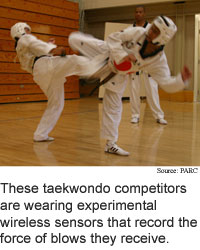
Sensors track martial arts blows
Ubiquitous computing aims to allow a wide
range of usually non-computer aided human activities to take advantage
of computer processing by planting sensors throughout an environment and
moving computers into the background.
Researchers from Palo Alto Research Center (PARC), Stanford University,
and Impact Measurement have brought computers into a martial arts sparring
ring with a system that senses the force of a hit.
The researchers are testing the system in tae kwon do matches.
Information from the sensors combined with the judges' calls makes for
more accurate scoring, according to the researchers. The method could
also be used for sensing impact in other contact sports and also for videogames.
Tae kwon do competitors earn points for accurate, powerful kicks
delivered to a scoring region of a competitor's body. The system uses
wireless piezoelectric pressure sensors planted in the hogu, or body protector
worn by a competitor. Piezoelectric materials transfer vibration into
electricity and vice versa. The sensors transfer the force of impact into
a readable electrical signal that is wirelessly transmitted to a laptop
base station.
The system includes wireless handsets for the three judges, and
each sensor score has to be confirmed in real-time by a least two of the
judges. The sensor and handset data is processed by the laptop, which
also controls a score display.
The system is a more sophisticated version of the decades-old
fencing scorer, which uses wires and records contact but not force.
The method can be used now, according to the researchers.
Recognition keys access
Rules aim to get devices talking
Access patterns organize data
Atom-photon link demoed
Briefs:
Plastic nanowires sense gasses
Process nets cheap microstructures
Cursor speed shows virtual bumps
Sensors track martial arts blows
Nanotube moves molten metal
Buckyballs gain smaller kin

Research Watch blog
View from the High Ground Q&A
How It Works
RSS Feeds:
News
Ad links:
Buy an ad link
Ad links: Clear History
Buy an ad link
|
TRN
Newswire and Headline Feeds for Web sites
|
© Copyright Technology Research News, LLC 2000-2010. All rights reserved.